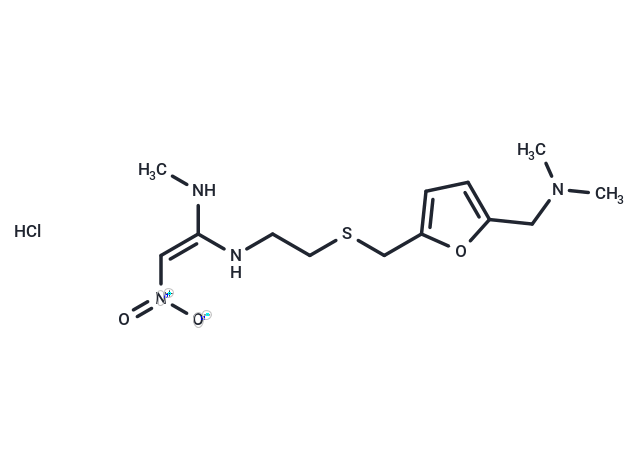Shopping Cart
Remove All Your shopping cart is currently empty
Your shopping cart is currently empty
Ranitidine Hydrochloride (AH19065) is a member of the class of histamine H2-receptor antagonists with antacid activity. Ranitidine is a competitive and reversible inhibitor of the action of histamine, released by enterochromaffin-like (ECL) cells, at the histamine H2-receptors on parietal cells in the stomach, thereby inhibiting the normal and meal-stimulated secretion of stomach acid. In addition, other substances that promote acid secretion have a reduced effect on parietal cells when the H2 receptors are blocked.

| Pack Size | Price | USA Warehouse | Global Warehouse | Quantity |
|---|---|---|---|---|
| 25 mg | $30 | In Stock | In Stock | |
| 50 mg | $43 | In Stock | In Stock | |
| 100 mg | $58 | In Stock | In Stock | |
| 200 mg | $67 | In Stock | In Stock | |
| 500 mg | $79 | In Stock | In Stock | |
| 1 mL x 10 mM (in DMSO) | $65 | In Stock | In Stock |
| Description | Ranitidine Hydrochloride (AH19065) is a member of the class of histamine H2-receptor antagonists with antacid activity. Ranitidine is a competitive and reversible inhibitor of the action of histamine, released by enterochromaffin-like (ECL) cells, at the histamine H2-receptors on parietal cells in the stomach, thereby inhibiting the normal and meal-stimulated secretion of stomach acid. In addition, other substances that promote acid secretion have a reduced effect on parietal cells when the H2 receptors are blocked. |
| Targets&IC50 | H2 receptor:3.3 ± 1.4 μM |
| In vitro | Ranitidine sensitizes hepatocytes to killing by cytotoxic products from activated neutrophils, whereas Famotidine lacks this ability. [1] Ranitidine inhibits the production of tumor necrosis factor-alpha (TNF-alpha) in monocytes stimulated with lipopolysaccharide in vitro. [2] Ranitidine reduces the Kel of morphine dose-dependently with a maximum effect of 50%, and increases the relative concentration of morphine-6-glucuronide to morphine-3-glucuronide in isolated guinea pig hepatocytes. Ranitidine gradually decreases the morphine-3-glucuronide/morphine-6-glucuronide ratio by up to 21%. [3] |
| In vivo | Ranitidine results in liver injury as evidence by increased in serum alanine aminotransferase, aspartate aminotransferase, and gamma-glutamyl transferase activities within 6 hours after Ranitidine administration in rats. [1] Ranitidine inhibits hepatic ischemia/reperfusion-induced increase in hepatic tissue levels of TNF-alpha, cytokine-induced neutrophil chemoattractant, and hepatic accumulation of neutrophils in rats. [2] Ranitidine cotreatment enhances LPS-induced coagulation prior to liver injury, and anticoagulants reduce liver damage in LPS/RAN-treated rats. Ranitidine /LPS-treated rats results in the formation of fibrin clots in liver sinusoids, and prevention of fibrin deposition associated with reduced hepatocellular injury. Ranitidine cotreatment enhances the LPS-induced TNF increase before the onset of hepatocellular injury in rats. [4] Ranitidine displays anxiolytic effects in the elevated plus-maze as indicated by an increase in time spent in the open arms, more open-arm scanning and more end-excursions in rats. [5] |
| Synonyms | AH19065 |
| Molecular Weight | 350.86 |
| Formula | C13H23ClN4O3S |
| Cas No. | 66357-59-3 |
| Smiles | Cl.CN\C(NCCSCc1ccc(CN(C)C)o1)=C\[N+]([O-])=O |
| Relative Density. | no data available |
| Storage | Powder: -20°C for 3 years | In solvent: -80°C for 1 year | Shipping with blue ice/Shipping at ambient temperature. | |||||||||||||||||||||||||||||||||||
| Solubility Information | H2O: 142.51 mM, Sonication is recommended. DMSO: 60 mg/mL (171.01 mM), Sonication is recommended. | |||||||||||||||||||||||||||||||||||
| In Vivo Formulation | 10% DMSO+40% PEG300+5% Tween 80+45% Saline: 2 mg/mL (5.7 mM), Sonication is recommended. Please add the solvents sequentially, clarifying the solution as much as possible before adding the next one. Dissolve by heating and/or sonication if necessary. Working solution is recommended to be prepared and used immediately. The formulation provided above is for reference purposes only. In vivo formulations may vary and should be modified based on specific experimental conditions. | |||||||||||||||||||||||||||||||||||
Solution Preparation Table | ||||||||||||||||||||||||||||||||||||
H2O/DMSO
| ||||||||||||||||||||||||||||||||||||
| Size | Quantity | Unit Price | Amount | Operation |
|---|

Copyright © 2015-2025 TargetMol Chemicals Inc. All Rights Reserved.